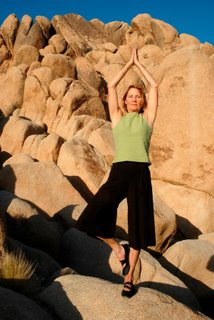
Tree Pose
One of the most recognizable yoga asanas, Vrksasana (Tree Pose) has been identified in Indian relics dating back to the seventh century. “A figure standing in a one-legged balance is part of a famous stone carving in the town of Mahabalipuram,” says Tias Little, the director of YogaSource in Santa Fe, New Mexico. In ancient times, he says, wandering holy men called sadhus would meditate in this posture for long periods of time as a practice of self-discipline.
In some traditions, the pose is called Bhagirathasana, to honor a great yogi king from India who—legend says—stood on one leg for a long time to appease the Hindu god Shiva and to be allowed to bring the sacred river Ganges from heaven to earth. “This posture represents the intense penance of Bhagiratha,” says Kausthub Desikachar, son and student of the yoga master T.K.V. Desikachar and chief executive of the Krishnamacharya Yoga Madiram in Chennai, India. “It’s supposed to motivate us to work toward our goal even if there are many obstacles in the way.” That doesn’t mean you have to stand on one leg for years. “The point is to make a dedicated effort to one’s practice,” he says. “It makes us strong, it enhances our willpower, and we achieve amazing benefits.”
This ancient, reliable pose is often the first balance posture you learn, since it’s relatively simple and strengthens your legs and spine and opens your thighs and hips. When you practice balancing poses, you learn some practical lessons in how to get grounded, find your center, stay focused, and steady your mind. Plus, the process—falling and trying again—helps develop patience and persistence, humility, and good humor.
Boost your balance
Learning to balance often has more to do with your mental state than your physical abilities. If you’re stressed, or if your mind is scattered, your body is likely to be unsteady, too. And, of course, the very practice of trying to balance is stressful. Most of us, as we try to balance, have unsettling thoughts like “I can’t do this” or “Everyone’s watching me wobble.”
Luckily, there are three tools you can use to quiet distracting mental chatter and steady your mind:
1. Be aware of your breath. Paying attention to your breath helps unite body and mind and establish a state of physiologic calm. As yoga master B.K.S. Iyengar writes in his classic guide, Light on Yoga, “regulate the breathing, and thereby control the mind.”
2. Direct your gaze. Also called drishti, a steady gaze helps focus your mind. In Vrksasana, anchoring your gaze on the horizon or a fixed point directs energy forward to keep you upright.
3. Visualize your tree. Imagine that you are a tree—with your feet rooted firmly in the earth and your head extending up toward the sun. Take a moment to meditate on what “tree” means to you and find an image that suits your body and temperament—a graceful willow, a solid oak, a flirty palm. Invite this mental picture to guide you toward stability.
Posted in yoga, Yoga Timer, Yoga Timers by Now & Zen